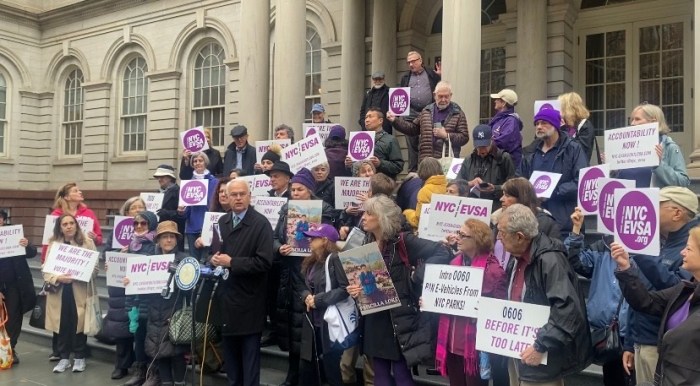By Brian M. Rafferty
In their Lower East Side walk-up, filmmakers Terri Marlow and Curtis Cates have a scaled down version of a Hollywood editing studio, replete with high-tech digital video editing machines, audio mixers, old-fashioned tape splicers and a host of other pieces too technical to explain.
The duo, who recently premiered their latest project, “Peace Through Understanding: The 1964-65 New York World’s Fair” at Flushing Town Hall, spent the last nine years working on the film which is about one of their favorite abandoned places — Flushing Meadows Corona Park.
“We just fell in love with the fairgrounds,” Marlow said. “We both are very interested in abandoned places.”
“The fair was a huge accomplishment, both individually and collectively, and now there is very little left to show for it,” Cates said.
The film documents the fair, from the initial announcement that it would happen, to New York legend Robert Moses being appointed as head of the fair committee, to its constructions and eventual demolition.
“So many of the people involved called it the most significant part of their career,” Cates said.
“It really was their ‘jewel in the crown’ for their careers, and we got to a lot of these people probably at just the right time,” Marlow said. “Ten years ago people might not have been as interested to talk about it, but a lot of these people are now retired or close to retiring and look back at this as a highlight of their careers.”
Cates points out that the film poses a very interesting question: “Why does the 1964 World’s Fair merit such memories when people can go to Six Flags for an exciting day? There’s just something very special about it.”
That statement rang true two weeks ago when the film was premiered. The steps of Flushing Town Hall were overflowing with hopefuls wishing to get inside. Dozens had to be turned away. As people ate hot dogs and hamburgers before the film they discussed their own memories, and when they snacked on Belgian waffles afterward their faces were glowing, some had tears in their eyes and everybody gave a standing ovation to the filmmakers.
The lasting memories of the fair were obviously very strong for those who attended both the fair and the film premiere, evidence that the fair, on its own, had touched so many lives — not always in the best way.
“We met with the architect of the RCA pavilion, and he was so heartbroken by the destruction of the building afterward that he never built another above-ground piece of architecture,” Cates said. “It changed his life seeing it torn down.”
The discussion with that architect was just the tip of the iceberg for the information the duo, which operates under the name BBQ Productions, had uncovered. Besides conducting interviews with dozens of people related to the fair, they also sifted through about 200 hours of archival footage, newsreels, old interviews and films made about the fair for their film.
Whittling that down to about an hour and 45 minutes was a monumental task. Citing the four-hour interview with James Farmer, the president of the Congress on Racial Equity (CORE), Marlow said “In the height of his career he could have picked up a phone and gotten President (Lyndon) Johnson, Martin Luther King, Malcolm X or anybody else on the line.” Farmer led CORE on a protest for Civil Rights on the opening day of the fair. “His interview in itself could be a documentary,” she added.
And that was one of the problems facing Cates and Marlow — deciding what would go in and what was, perhaps, too tangential to make sense in the final cut. “There we so many great stories that didn’t make it,” Cates said. “But our goal for the film was to make something interesting for someone who was not previously interested in the World’s Fair at all.”
Of course the volume of the film’s potential content is comparable to the event itself. Situated on 640 acres, people who lived in New York came several times over the duration of the fair to try to take in it all. Those visiting from out of town likely were focused on seeing particular sites, such as the Pieta, Michelangelo’s sculpture of Jesus and Mary after he was taken off the cross. The famous sculpture was sent to New York on loan from the Vatican and was displayed in the Vatican pavilion for the duration of the fair. It was the most visited site.
But the fair was not about art, or anything that already existed in New York, and Robert Moses made no bones about that. “His point was that New York already had an abundance of fine art, and if people wanted to see that there were plenty of institutions in Manhattan that they could go to,” Cates said.
Over the years, World’s Fair interest has remained high, Internet-based interest groups exchange pictures and stories from the fair, memorabilia sells for astronomical numbers and, occasionally, people get together to reminisce about the fair.
“In 1995 we did a show, ‘Something for Everyone,’ at Flushing Town Hall,” Cates said. The show was set up to mark the 30th anniversary of the fair, and featured a display of memorabilia from the fair.
Though fair guides and paperwork from various pavilions change hands regularly on eBay and other on-line venues, there is very little left of the structures at the fair.
One of the most touching moments of the film is some footage of the aftermath of the fair — inside the General Electric pavilion, which had Progressland, which included the first-ever public display of nuclear fusion. The day after the fair ended crews came in and smashed everything. A home movie takes the viewer through the wreckage where the filmer could not find a single scrap worth saving since the interior had been so thoroughly destroyed.
The film ends with two dancers from the DuPont pavilion having a picnic on the site of where their stage had been. It was a nostalgic moment for them as the sat on the grass in this area that had once been a thriving city unto itself — from April 1964 to October 1965.
With the film in its screening stage, Cates and Marlow are now turning their attention to finding distribution for it and to hold additional screenings.
“We would love for it to be on PBS,” Cates said. “We’ll start there and work our way down.” At the very least, they plan to release it on DVD and VHS for the home video market.
And they also want to have more screenings in Queens and Manhattan, though no dates have been set.
While “Peace Through Understanding” enters the marketing and distribution phase, BBQ Productions is starting the legwork on its next documentary, a piece on the music scene in New York between 1965 and 1975. “But a lot depends on what happens with this film,” Cates said.


































